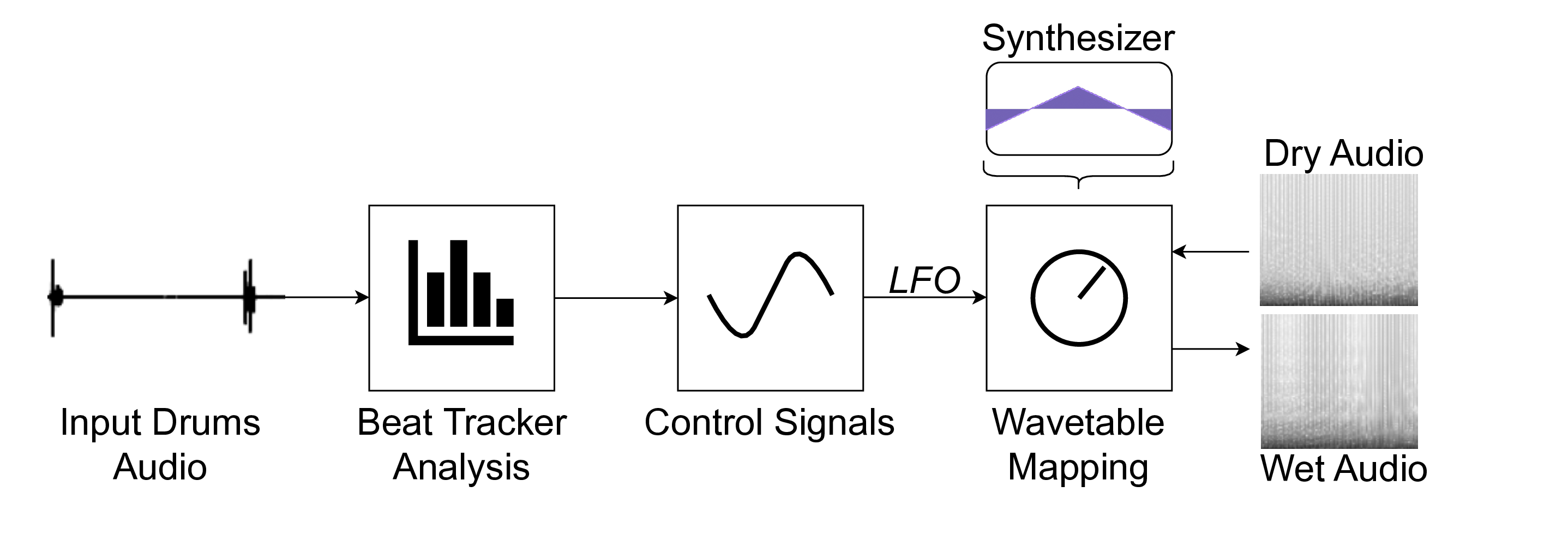Real-Time Beat Tracking for Creative Music Production
This is the accompanying website for the Bachelor Thesis [1].
- Ole Frederik Müermann
Real-Time Beat Tracking for Creative Music Production
Bachelor Thesis, Friedrich-Alexander-Universität Erlangen-Nürnberg (FAU), 2024. Demo@misc{Müermann24_RealTimeBeatMusicProduction_Bachelor_Thesis, title = {Real-Time Beat Tracking for Creative Music Production}, author = {Ole Frederik Müermann}, year = {2024}, note = {Bachelor Thesis, Friedrich-Alexander-Universität Erlangen-Nürnberg (FAU)}, url-demo = {https://audiolabs-erlangen.de/resources/MIR/2024-RealTimeBeat-MusicProduction} }

Abstract
Music production and mixing involve the use of numerous audio effects, with parameters that need to be controlled. While manual control is possible, automation greatly enhances efficiency. This thesis presents a collection of creative digital audio effects and audio examples for real-time beat tracking. A new real-time procedure based on the predominant local pulse (PLP) method is introduced, as described in [2] and [3]. This beat tracker can extract two types of control signals: First, a low-frequency oscillation (LFO), and second, a confidence measure for beat stability. LFOs are used in audio signal processing where an oscillating signal with a frequency below the audible range (typically below 20 Hz) modulates various audio parameters, such as amplitude or filter frequency. The main focus of this thesis lies on a library of case studies on creative audio effects. Selected effects are presented using a demo track produced in the digital audio workstation (DAW) Ableton Live. The pre-generated control curves from the beat tracker are utilized to automate effect parameters synchronized with the beat of the music. Subsequently, the audio examples are demonstrated using Jupyter Notebooks. This study on creative music production aims to serve as a source of inspiration for music producers and sound engineers in potential applications and the further development of real-time beat tracking systems.
Audio Examples
Demo Track Overview
In this first example, we provide an overview of our demo track with (wet) and without (dry) effects. The figures show the waveform, song structure, and tempo (BPM) over time.

Table of Effects
With this table, we provide a description of the effects used for mixing the track. We include information on the control signals used, as well as the input signal to the beat tracker, the tempo range, the kernel size, and the lookahead parameter.
| ID | Effect Description | Control Signals | (Input, Tempo Range, Kernel Size, Lookahead) |
|---|---|---|---|
| 1 | Arpeggiator | gamma-LFO | (Kick, 100-140, 6, 0) |
| 2 | Formant | alpha-LFO | (Drums, 120-170, 6, 0) |
| 3 | Tremolo - Vocal Stutter | gamma-LFO | (Kick, 400-560, 2, 30) |
| 4 | Reverb Ducking and Mixing | alpha-LFO, beta-confidence | (Kick, 100-140, 2, 0) |
| 5 | Kick and Bass Sidechaining | alpha-LFO, beta-confidence | (Kick, 100-140, 6, 0) |
| 6 | Wavetable Synthesis - Timbre | gamma-LFO | (Drums, 120-170, 6, 0) |
Arpeggiator
An example of the arpeggiator effect...


Formant
An example of the formant effect...


Tremolo - Vocal Stutter
An example of the vocal stutter effect...


Reverb Ducking and Mixing
An example of reverb ducking and mixing...


Kick and Bass Sidechaining
An example of kick and bass sidechaining...


Wavetable Synthesis - Timbre
An example of wavetable synthesis timbre...


References
- Ole Frederik Müermann
Real-Time Beat Tracking for Creative Music Production
Bachelor Thesis, Friedrich-Alexander-Universität Erlangen-Nürnberg (FAU), 2024. Demo@misc{Müermann24_RealTimeBeatMusicProduction_Bachelor_Thesis, title = {Real-Time Beat Tracking for Creative Music Production}, author = {Ole Frederik Müermann}, year = {2024}, note = {Bachelor Thesis, Friedrich-Alexander-Universität Erlangen-Nürnberg (FAU)}, url-demo = {https://audiolabs-erlangen.de/resources/MIR/2024-RealTimeBeat-MusicProduction} } - Peter Meier, Ching-Yu Chiu, and Meinard Müller
A Real-Time Beat Tracking System with Zero Latency and Enhanced Controllability
Transactions of the International Society for Music Information Retrieval (TISMIR), 7(1): 213–227, 2024. Demo DOI@article{MeierCM24_RealTimePLP_TISMIR, author = {Peter Meier and Ching-Yu Chiu and Meinard M{\"u}ller}, title = {{A} Real-Time Beat Tracking System with Zero Latency and Enhanced Controllability}, journal = {Transactions of the International Society for Music Information Retrieval ({TISMIR})}, year = {2024}, volume = {7}, number = {1}, pages = {213--227}, doi = {10.5334/tismir.189}, url-demo = {https://audiolabs-erlangen.de/resources/MIR/2024-TISMIR-RealTimePLP} } - Peter Meier, Simon Schwär, and Meinard Müller
A Real-Time Approach for Estimating Pulse Tracking Parameters for Beat-Synchronous Audio Effects
In Proceedings of the International Conference on Digital Audio Effects (DAFx): 314–321, 2024. Demo@inproceedings{MeierSM24_RealTimePulseParameters_DAFX, author = {Peter Meier and Simon Schw{\"a}r and Meinard M{\"u}ller}, title = {{A} Real-Time Approach for Estimating Pulse Tracking Parameters for Beat-Synchronous Audio Effects}, booktitle = {Proceedings of the International Conference on Digital Audio Effects ({DAFx})}, address = {Guildford, Surrey, {UK}}, year = {2024}, pages = {314--321}, url-demo = {https://audiolabs-erlangen.de/resources/MIR/2024-DAFx-RealTimePLP} }

